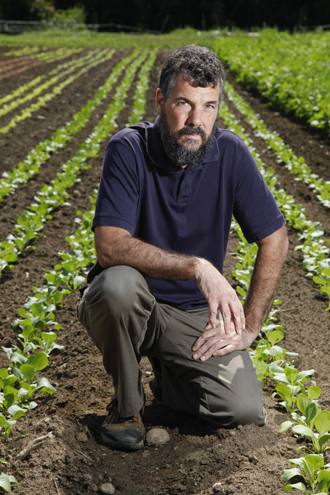New England agriculture and the evolving Thanksgiving table
 Photo/Mike Lovett
Photo/Mike LovettBrian Donahue, associate professor of environmental studies and a New England farming historian, says that some of what most Americans consume today during their Thanksgiving dinners has withstood the test of time. Donahue, also the lead-author of A New England Food Vision, a plan for the region to produce half its own food by 2050, says that producing most of what’s on the table locally is quite possible.
“Thanksgiving is a time to be thankful, for family, friends and the food we have to eat,” says Donahue. “A lot of what we’ll eat on Thursday has been grown here since the pilgrims arrived. The Thanksgiving menu has taken some twists and turns over the years, though.”
For example, while turkey is synonymous with the modern Thanksgiving, it was not the centerpiece of the pilgrims’ feast. Any turkey consumed at that dinner would have been hunted wild in the local forest.
“The turkey we eat today is a relative, domesticated thousands of miles away by Native Americans in Mexico. The Spanish took them back to Europe, where they eventually made their way in trade to England, and from there to New England with the English settlers,” explains Donahue.
The fruits and vegetables on the Thanksgiving table have changed over time, too. Potatoes weren’t part of the pilgrims’ feast, mashed or otherwise. The potato is native to Peru, but was brought to the U.S. after it became popular in Europe as an affordable, high calorie crop, says Donahue. The ancestor to our mashed potatoes arrived in Londonderry, NH via Scots-Irish settlers in 1720.
Carrots were brought by the pilgrims from home, as was the wheat used in bread for stuffing and piecrust—but wheat didn’t grow well in New England, and the settlers soon switched to Indian corn. Cranberries, on the other hand, were native and plentiful in the Plymouth area. Native Americans picked cranberries regularly, with the pilgrims probably turning the fruit into a sauce that is similar to what we use on Thanksgiving.
Butternut squash and pumpkins originated in Mexico but were growing in what would become the United States by the time the pilgrims arrived, and New England farmers quickly took to growing them, too.
 |
| Brian Donahue's Long Island cheese pumpkins. Photo/Brian Donahue |
A copy of a pie recipe using Long Island cheese pumpkins is available online.
Donahue says many people are becoming more aware of the ingredients they use to prepare their Thanksgiving dinner. “A lot of people are going ingredient by ingredient when they cook the meal. They are trying to get more of these heritage foods. If they do this, they’ll tap into some really interesting stories and more flavorful foods.”
Categories: General, Humanities and Social Sciences





